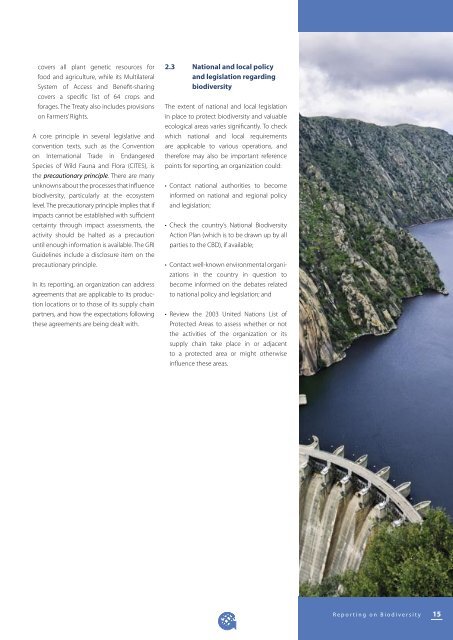Biodiversity - a GRI Reporting Resource - Global Reporting Initiative
Biodiversity - a GRI Reporting Resource - Global Reporting Initiative
Biodiversity - a GRI Reporting Resource - Global Reporting Initiative
You also want an ePaper? Increase the reach of your titles
YUMPU automatically turns print PDFs into web optimized ePapers that Google loves.
covers all plant genetic resources for<br />
food and agriculture, while its Multilateral<br />
System of Access and Benefit-sharing<br />
covers a specific list of 64 crops and<br />
forages. The Treaty also includes provisions<br />
on Farmers’ Rights.<br />
A core principle in several legislative and<br />
convention texts, such as the Convention<br />
on International Trade in Endangered<br />
Species of Wild Fauna and Flora (CITES), is<br />
the precautionary principle. There are many<br />
unknowns about the processes that influence<br />
biodiversity, particularly at the ecosystem<br />
level. The precautionary principle implies that if<br />
impacts cannot be established with sufficient<br />
certainty through impact assessments, the<br />
activity should be halted as a precaution<br />
until enough information is available. The <strong>GRI</strong><br />
Guidelines include a disclosure item on the<br />
precautionary principle.<br />
In its reporting, an organization can address<br />
agreements that are applicable to its production<br />
locations or to those of its supply chain<br />
partners, and how the expectations following<br />
these agreements are being dealt with.<br />
2.3 National and local policy<br />
and legislation regarding<br />
biodiversity<br />
The extent of national and local legislation<br />
in place to protect biodiversity and valuable<br />
ecological areas varies significantly. To check<br />
which national and local requirements<br />
are applicable to various operations, and<br />
therefore may also be important reference<br />
points for reporting, an organization could:<br />
• Contact national authorities to become<br />
informed on national and regional policy<br />
and legislation;<br />
• Check the country’s National <strong>Biodiversity</strong><br />
Action Plan (which is to be drawn up by all<br />
parties to the CBD), if available;<br />
• Contact well-known environmental organizations<br />
in the country in question to<br />
become informed on the debates related<br />
to national policy and legislation; and<br />
• Review the 2003 United Nations List of<br />
Protected Areas to assess whether or not<br />
the activities of the organization or its<br />
supply chain take place in or adjacent<br />
to a protected area or might otherwise<br />
influence these areas.<br />
R e p o r t i n g o n B i o d i v e r s i t y<br />
15

















